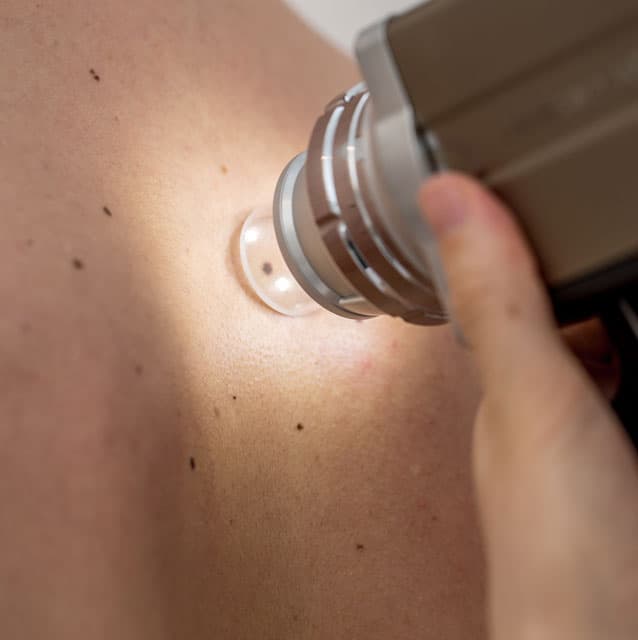Feel the burn? Explaining the science of sunscreen

At the University of Chicago Medicine, our dermatology experts often receive questions about how to stay safe in the sun. Using sunscreen is the best way to protect your skin from sun damage. However, have you ever wondered how it works? Or, why you still get burned even if you’ve put it on? Spoiler alert: You’re probably not using enough. Most adults need about two tablespoons of sunscreen to cover their body.
Here are answers to some frequently asked questions about sunscreen and keeping your skin safe.
What is SPF?
SPF, or sun protection factor, measures how well sunscreen protects against ultraviolet B (UVB) rays, which cause sunburn and play a major role in developing skin cancer. According to the Food and Drug Administration (FDA), SPF is “a relative measure of the amount of sunburn protection provided by sunscreens.”
The FDA’s description is based on the amount of solar exposure – a departure from the conventional view that SPF is based on the amount of time that someone is protected in the sun. This is because the amount of solar exposure changes throughout the day. For example, one hour of exposure at 9 a.m. is comparable to 15 minutes of exposure at 1 p.m. Therefore, SPF numbers provide more of a guideline, letting consumers know that higher SPF numbers correspond to higher levels of protection against sunburn. That said, no sunscreen, regardless of how high the SPF, is effective for more than two hours without reapplication.
What is the science behind sunscreen?
Sunscreens are classified as both organic, or chemical, and inorganic, or physical. Organic compounds, such as oxybenzone and octinoxate, work like sponges to absorb UV radiation. Inorganic compounds, containing zinc oxide and/or titanium dioxide, shield the skin to reflect and scatter UV radiation. A broad-spectrum sunscreen contains compounds that absorb and/or reflect UVB rays in addition to Ultraviolet A (UVA) rays, the ones that age skin and cause wrinkles. Many types of sunscreens in the U.S. combine organic and inorganic compounds to provide this kind of broad-spectrum protection.
What is the minimum SPF you should use? Is a higher SPF really that much better for you?
We recommend a broad-spectrum sunscreen with SPF 30 or higher. We know that SPF 15 blocks about 93 percent of UVB rays, SPF 30 blocks 97 percent and SPF 50 blocks 98 percent. No sunscreen blocks all UV rays yet, which is why it is important to practice other sun-protective measures. While sunscreens with higher SPF block slightly more UV rays, they last the same amount of time as a lower-number SPF sunscreen and should be reapplied after two hours.
How much sunscreen should I use and when should I apply it?
To cover the body, most adults need approximately one ounce — or, two tablespoons. For the face alone, a nickel-size dollop is recommended. You should apply sunscreen to dry skin 15 to 30 minutes before going outside. When outdoors, reapply every two hours, or after swimming, toweling off or sweating. Sport or water-resistant sunscreen will stay on wet skin for 40 to 80 minutes. It’s best to practice sun protection daily, even on cloudy or cool days. Sand and water (and snow!) reflect sunlight.
What kind of sunscreen is best?
Organic sunscreens are usually easier than inorganic sunscreens to rub into the skin without leaving white residue. People with sensitive skin should use inorganic sunscreen, since it’s hypoallergenic and less likely to irritate your skin. Creams are best for dry skin. Lotions are thinner, less greasy, and generally preferred for large body areas. Gels are good for hairy parts of the skin such as the scalp. Sprays are sometimes preferred because they’re easier to apply, especially on children. However, it’s difficult to know if you’re applying enough to cover a specific area. Spraying into your hands first helps to make sure that you’re adequately covered as well as to avoid inhalation. You could also consider applying cream initially, then using spray when reapplying.
How effective is sun-blocking clothing?
Clothing is an additional protective tool that provides a physical barrier to UV rays. The degree of protection is defined by the ultraviolet protection factor (UPF) and determined by the garment's fabric and and how it’s made. A shirt with a UPF of 50 allows just 1/50th of rays to reach your skin versus a thin white cotton T-shirt with a UPF of 5.
What are the best remedies for sunburn?
Aloe vera-based gels can provide pain relief. Treat sunburns as soon as possible by avoiding continued exposure, taking a cool bath, putting on over-the-counter hydrocortisone cream, taking an oral NSAID such as ibuprofen, and staying hydrated. Do not pick at a peeling sunburn; instead, apply a fragrance-free moisturizer. If you have a sunburn with severe blistering on a large part of your body, and/or severe pain and symptoms such as a fever, headache or vomiting, seek medical care immediately.
Is sunscreen only needed in the summer?
UV rays from the sun are emitted year-round. On cloudy days, up to 90% of UV rays can pass through the cloud cover. Additionally, snow can reflect up to 80% of UV rays. UV radiation increases at higher altitudes – worth keeping in mind for outdoor activities in both warmer and colder seasons.

Get Screened for Skin Cancer
Some people have a higher risk of developing skin cancer, but anyone can get it, regardless of skin color or family medical history. If skin cancer is detected at an early stage, it's easier to treat. Our experienced dermatologists offer skin cancer screenings at several convenient locations in Chicago and the suburbs.
Learn more about skin cancer screeningAbout the Authors
Arlene Ruiz de Luzuriaga, MD, MPH, MBA, and Oluwakemi Onajin, MD are UChicago Medicine dermatologists and part of our expert skin specialist team.


